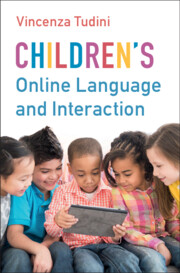Book contents
- Children’s Online Language and Interaction
- Children’s Online Language and Interaction
- Copyright page
- Dedication
- Contents
- Figures and Tables
- Preface
- Acknowledgements
- Transcription Conventions
- 1 What Is Talk and Why Do Children Need It?
- 2 Beyond Emotions: Emoji Talk
- 3 Penguin Talk
- 4 Video Game Talk
- 5 Minecraft Interaction
- 6 Children’s YouTube Comments on Ethan Gamer
- 7 Online Grooming Talk
- 8 Summary of Findings, Implications, and Guidelines
- Appendix: Data Table
- References
- Index
5 - Minecraft Interaction
Published online by Cambridge University Press: 19 December 2024
- Children’s Online Language and Interaction
- Children’s Online Language and Interaction
- Copyright page
- Dedication
- Contents
- Figures and Tables
- Preface
- Acknowledgements
- Transcription Conventions
- 1 What Is Talk and Why Do Children Need It?
- 2 Beyond Emotions: Emoji Talk
- 3 Penguin Talk
- 4 Video Game Talk
- 5 Minecraft Interaction
- 6 Children’s YouTube Comments on Ethan Gamer
- 7 Online Grooming Talk
- 8 Summary of Findings, Implications, and Guidelines
- Appendix: Data Table
- References
- Index
Summary
This chapter applies principles outlined in previous chapters, especially Chapter 4 Videogame Talk, to understand group written interaction between Ethan Gamer and his fans, as visible on a public YouTube Minecraft gaming session. Unlike games such as FIFA where game objectives and points scoring dominate, Minecraft involves building digital environments, similar to Lego. The game software facilitates both written and spoken talk for the collaborative achievement of game activities, though survival and progression through levels are objectives in most Minecraft contexts. Analysis indicates that affiliative social talk, including reciprocal greetings, positive evaluations and smiley emoticons deployed by game participants promote a supportive gaming environment while also modeling prosocial affiliative gaming behaviours. Teamwork and problem-solving behaviours which scaffold game participants in their game play are also enacted frequently and reciprocally in text chat. These include requests or offers of assistance and advice giving related to the game-in-progress, including coordination of defensive actions as a result of a threat, which may require collaborative team work to progress the game. Both Ethan Gamer’s voice interaction and the group chat interactions promote a supportive prosocial environment which can be shared with all participants, including YouTube viewers.
Keywords
- Type
- Chapter
- Information
- Children's Online Language and Interaction , pp. 98 - 131Publisher: Cambridge University PressPrint publication year: 2025

